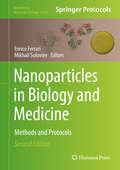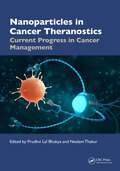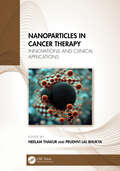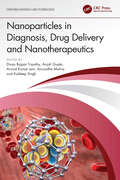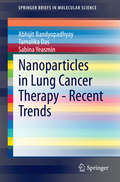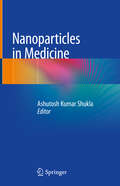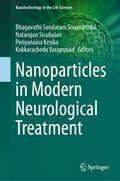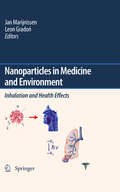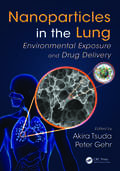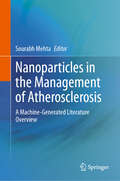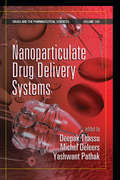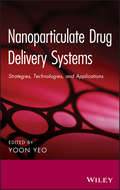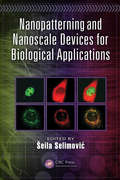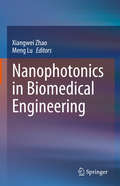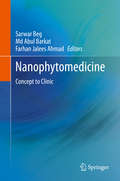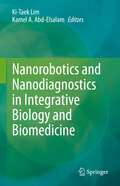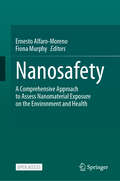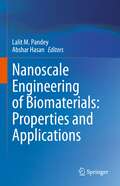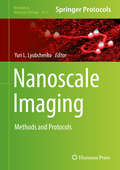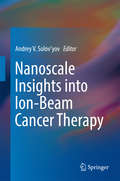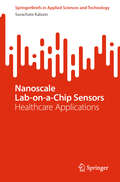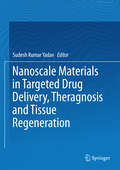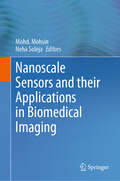- Table View
- List View
Nanoparticles in Biology and Medicine
by Mikhail SolovievThe modern fascination with micro- and nano-sized materials can actually be traced back further to the 1960s and '70s when the first few reported attempts were made to use nanoparticles for controlled drug delivery. In Nanoparticles in Biology and Medicine: Methods and Protocols, experts in the field present a wide range of methods for synthesis, surface modification, characterization, and application of nano-sized materials (nanoparticles) in life science and medical fields, mostly for drug delivery. The methods presented cover all stages of nanoparticle manufacturing, modification, analysis, and applications. Written in the highly successful Methods in Molecular BiologyTM series format, chapters include introductions to their respective topics, lists of the necessary materials and reagents, step-by-step, readily reproducible laboratory protocols, and tips on troubleshooting and avoiding known pitfalls. Comprehensive and cutting-edge, Nanoparticles in Biology and Medicine: Methods and Protocols will help the beginner become familiar with this fascinating field and will provide scientists at all levels of expertise with easy-to-follow practical advice needed to make, modify, and analyze nanoparticles of their choice and to use them in a wide range of biomedical and pharmaceutical applications, including functional protein studies, drug delivery, immunochemistry, imaging, and many others.
Nanoparticles in Biology and Medicine: Methods And Protocols (Methods In Molecular Biology Ser. #906)
by Mikhail Soloviev Enrico FerrariThis fully updated volume presents a wide range of methods for synthesis, surface modification, characterization and application of nano-sized materials (nanoparticles) in the life science and medical fields, with a focus on drug delivery and diagnostics. Beginning with a section on the synthesis of nanoparticles and their applications, the book continues with detailed chapters on nanoparticle derivatization, bio-interface, and nanotoxicity, as well as nanoparticle characterization and advanced methods development. Written for the highly successful Methods in Molecular Biology series, chapters include introductions to their respective topics, lists of the necessary materials and reagents, step-by-step, readily reproducible laboratory protocols, and tips on troubleshooting and avoiding known pitfalls. Authoritative and cutting-edge, Nanoparticles in Biology and Medicine: Methods and Protocols, Second Edition serves as an ideal guide for scientists at all levels of expertise to a wide range of biomedical and pharmaceutical applications including functional protein studies, drug delivery, immunochemistry, imaging, and more.
Nanoparticles in Cancer Theranostics: Current Progress in Cancer Management
by Prudhvi Lal Bhukya Neelam ThakurThis book comprehensively reviews the application of nanoparticles in cancer diagnosis and treatment. The introductory section provides a fundamental understanding of cancer biology, its global incidence and prevalence, and the intricate nano–bio interactions at the cellular level. The subsequent section discusses the pivotal role of nanoparticles in precise cancer detection, enhancing cancer imaging and serving as contrast agents for accurate diagnosis. It also presents cutting-edge nanotechnology-based methods for detecting HTLV-1 retroviruses. The following section covers the utilization of lipid-based nanoparticles, monoclonal antibodies, and advanced nanotherapeutics for targeted cancer treatments. This book is a useful resource for researchers, clinicians, and students in the fields of oncology and nanotechnology.
Nanoparticles in Cancer Therapy: Innovations and Clinical Applications
by Neelam Thakur and Prudhvi Lal BhukyaThis book presents the role of nanoparticles in cancer therapy, emphasizing their innovative applications across treatment, diagnosis and the development of therapeutic strategies. The first section of the book describes the applications of nanoparticles in cancer vaccines and gene therapy. It features discussions on polymeric nanoparticles as nanovaccine carriers, membrane-based nano-vaccines for immunotherapy and gene therapy techniques employing nanoparticles. The second section presents advanced nanomedicine approaches, specifying the role of chemodynamic nanoparticles in cancer theranostics, the application of low-dimensional nanomaterials and emerging strategies against drug resistance. Additionally, it explores nanotechnology in radiation therapy, phototherapy modalities and bioengineered virus-like nanoparticles for diagnostics and therapeutics. The last section reviews the clinical applications and prospects, examining theranostic nanoparticles, the clinical translation of nanomedicine and the current limitations of cancer nanotherapy. It also addresses future directions in nanoparticle application, and examines the genotoxicity, immunotoxicity, cytotoxicity assessments, safety profiles, targeted drug delivery, and their role in viral oncogenesis. This book is a useful resource for researchers, clinicians and students in the fields of oncology and nanotechnology.
Nanoparticles in Diagnosis, Drug Delivery and Nanotherapeutics (Emerging Materials and Technologies)
by Anuradha Mishra Arvind Kumar Jain Kuldeep Singh Divya Bajpai Tripathy Anjali GuptaThe integration of nanotechnology with biomaterials, diagnostic tools, analytical equipment, physiotherapy kits, and drug delivery agents has resulted in nanotherapeutics illustrated as a class of medicine with potential of research and development. This book illustrates synthesis, properties, and applications of nanotherapeutics in various healthcare-related issues including treatment of cancer, Alzheimer’s disease, targeted drug delivery, anti-HIV-1 nanotherapeutics, antibacterial/antiviral agents, skin therapy, and hyperthermia. Features: Consolidates different aspects of nanoparticles such as synthesis and types of nanotherapeutics in a detailed manner. Presents categorical classification of nanoparticles as therapeutics. Covers the sustainability of nanotherapeutics. Reviews fabrication and advancement of all categories of nanotherapeutics. Discusses specific applications such as in cancer therapy, skin treatments, and targeted drug delivery. This book is aimed at researchers, professionals, and senior undergraduate students in materials and medical science, biomedical engineering, and nanotechnology
Nanoparticles in Lung Cancer Therapy - Recent Trends
by Abhijit Bandyopadhyay Tamalika Das Sabina YeasminThis brief provides an insight into the present scenario of the role of nanotechnology in the diagnosis and treatment of lung cancer at an early stage. Currently, lung cancer is the subject of major concern owing to the very high mortality rate throughout the world. Most of the conventional treatment methods such as surgery, chemotherapy, radiotherapy, etc. , fail to prolong life of the patients. Incidents of recurrence are also very common in case of lung cancer. Researchers have shown that nanoparticles may act as a powerful anti cancer tool, especially for lung cancer. Unique surface properties and easy surface functionalization of nanoparticles enable early detection, diagnosis, imaging and treatment of lung cancer. The authors have elaborately presented how various nanoparticles (natural, semi synthetic and synthetic) may help in the treatment of lung cancer. They have also detailed works of various scientists who succeeded in developing effective nanoparticles and enabled very specific lung cancer therapy without any undesirable side effects and minimized death.
Nanoparticles in Medicine
by Ashutosh Kumar ShuklaThis book describes the medical applications of inorganic nanoparticles. Nanomedicine is a relatively advanced field, which enhances the treatment of various diseases, offering new options for overcoming the problems associated with the use of conventional medicines. Discussing the toxicological and safety aspects associated with medical applications of nanoparticles, the book presents the latest research on topics such as emerging nanomaterials for cancer therapy, applications of nanoparticles in dentistry, and fluoride nanoparticles for biomedical applications, and also includes chapters on the use of nanoparticles such as silver and gold.
Nanoparticles in Modern Neurological Treatment (Nanotechnology in the Life Sciences)
by Bhagavathi Sundaram Sivamaruthi Natarajan Sisubalan Periyanaina Kesika Kokkarachedu Varaprasad“Nanoparticles in Modern Neurological Treatment" provides a comprehensive exploration of the promising field of nanoparticles and their applications in neurology. The book begins with an introduction, laying the foundation by elucidating the properties and applications of nanoparticles in neurological therapies and diagnostics. The introduction provides an overview of nanoparticles, their properties, and their applications in neurological disorders, discussing the rationale behind using nanoparticles in neurological therapies and diagnostics. Subsequent chapters delve into specific areas of nanoparticle utilization, exploring how nanoparticles are utilized to overcome the blood-brain barrier and effectively deliver therapeutics to the brain for treating various neurological disorders. Nanoparticle-based imaging techniques for diagnosis and monitoring of neurological disorders are examined, along with targeted therapies for neurodegenerative diseases and brain tumors. Additionally, the modulation of inflammation and neuroprotection facilitated by nanoparticles, particularly relevant in conditions like multiple sclerosis and stroke, is discussed. The potential of nanoparticles as biomarkers for diagnosing and tracking neurological disorders is also investigated. Advanced applications include neuroregeneration and repair facilitated by nanoparticles and the emerging field of theranostics combining therapy and diagnosis using nanoparticles in neurological disorders. Lastly, the promising realm of nanoparticle-mediated gene therapy is explored for precision treatment of neurological conditions. By consolidating current knowledge and exploring future potentials, this book seeks to contribute to advancements in neurology, ultimately improving patient outcomes and quality of life.
Nanoparticles in medicine and environment
by Leon Gradon J. C. MarijnissenA huge effort is put into the science of nanoparticles and their production. In many cases it is unavoidable that nanoparticles are released into the environment, either during the production processes or during the use of a product made from these particles. It is also realized that combustion processes like traffic and power plants release nanoparticles into the atmosphere. However it is not known how nanoparticles interact with the human body, especially upon inhalation. At the same time research activities are devoted to understand how nano-sized medicine particles can be used to administer medicines via inhalation. In any case it is absolutely necessary to know how the nanoparticles interfere with the inhalation system, how they deposit and affect on the human system. Three main themes are discussed: Nanoparticle sources and production Nanoparticle inhalation and deposition Toxicological and medical consequences of nanoparticles Each theme is covered comprehensively, starting at nano-quantum effects up to technical and medical applications such as measuring equipment and inhalation instrumentation. This book brings together all sub-disciplines in the field related to aerosol nanoparticles. Each chapter is written by a world expert, giving the state of the art information and challenging open questions. The last chapter summarizes in an interdisciplinary way what is already known and what still is ahead of us.
Nanoparticles in the Lung: Environmental Exposure and Drug Delivery
by Peter Gehr Akira TsudaNanoparticles have a physical dimension comparable to the size of molecular structures on the cell surface. Therefore, nanoparticles, compared to larger (e.g., micrometer) particles, are considered to behave differently when they interact with cells. Nanoparticles in the Lung: Environmental Exposure and Drug Delivery provides a better understanding
Nanoparticles in the Management of Atherosclerosis: A Machine-Generated Literature Overview
by Sourabh MehtaThe book's primary objective is to introduce the pathology and physiology atherosclerosis in brief, and its diagnosis and treatment. Atherosclerosis is an inflammatory disease of the arterial wall. An advanced understanding of atherosclerosis shows that it leads to myocardial infarction and other cardiovascular diseases, taking 17 million people every year worldwide. The literature suggests that atherosclerosis is an ancient disease and is still a long-standing health problem globally. Hence early diagnosis and treatment of atherosclerosis are crucial to solving long-standing health issues.This book provides a systemic summary of recent literature focusing on disease pathology, advancement in diagnosis and therapies. Recently, nanoparticles performing dual roles as diagnostic and therapeutic agents have been keenly interested. However, the nanoparticle has yet to reach the clinic. Understanding the role of biomaterials in formulations and existing strategies is critical whendeveloping novel formulations and working on translation to clinical settings. The book provides a systematic biomaterial-based summary of the literature, methods used to formulate nanoparticles, and their scale-up potential. Another key objective of the book is to motivate the reader to conduct research on theranostic nanoparticles to treat atherosclerosis and put us one step closer to solving a long-standing health problem—atherosclerosis.The auto-summaries have been generated by a recursive clustering algorithm via the Dimensions Auto-summarizer by Digital Science handled by Subject Matter Experts and the external editor. The editor of this book selected which SN content should be auto-summarized and decided its order of appearance. Please be aware that the auto-summaries consist of original sentences, but are not representative of its original paper, since we do not show the full length of the publication. Please note that only published SN content is represented here, and that machine-generated books are still at an experimental stage.
Nanoparticulate Drug Delivery Systems: Barriers And Application Of Nanoparticulate Systems (Drugs And The Pharmaceutical Sciences Ser. #Vol. 166)
by Yashwant Vishnupant Pathak Deepak Thassu Michel DeleersWith the advent of analytical techniques and capabilities to measure particle sizes in nanometer ranges, there has been tremendous interest in the use of nanoparticles for more efficient methods of drug delivery. Nanoparticulate Drug Delivery Systems addresses the scientific methodologies, formulation, processing, applications, recent trends, and e
Nanoparticulate Drug Delivery Systems: Strategies, Technologies, and Applications
by Yoon YeoFrank discussions of opportunities and challenges point the way to new, more effective drug delivery systems Interest in nanomedicine has grown tremendously, fueled by the expectation that continued research will lead to the safe, efficient, and cost-effective delivery of drugs or imaging agents to human tissues and organs. The field, however, has faced several challenges attempting to translate novel ideas into clinical benefits. With contributions from an international team of leading nanomedicine researchers, this book provides a practical assessment of the possibilities and the challenges of modern nanomedicine that will enable the development of clinically effective nanoparticulate drug delivery products and systems. Nanoparticulate Drug Delivery Systems focuses on the rationales and preclinical evaluation of new nanoparticulate drug carriers that have yet to be thoroughly reviewed in the literature. The first chapter sets the stage with a general overview of targeted nanomedicine. The book then explores new and promising nanoparticulate drug delivery systems, including: Lipid nanoparticles for the delivery of nucleic acids Multifunctional dendritic nanocarriers Polymer drug nanoconjugates Next, the book presents new opportunities and challenges for nanoparticulate drug delivery systems, including: Clearance of nanoparticles during circulation Drug delivery strategies for combatting multiple drug resistance Toxicological assessment of nanomedicine Chapters offer state-of-the-technology reviews with extensive references to facilitate further investigation. Moreover, each chapter concludes with an expert assessment of remaining challenges, pointing the way to solutions and new avenues of research. With its frank discussions of opportunities and challenges, Nanoparticulate Drug Delivery Systems sets a solid foundation for new research leading to the discovery and development of better nanomedicines.
Nanopatterning and Nanoscale Devices for Biological Applications (Devices, Circuits, and Systems)
by Krzysztof Iniewski Šeila SelimovićNanoscale techniques and devices have had an explosive influence on research in life sciences and bioengineering. Reflecting this influence, Nanopatterning and Nanoscale Devices for Biological Applications provides valuable insight into the latest developments in nanoscale technologies for the study of biological systems. Written and edited by experts in the field, this first-of-its-kind collection of topics: Covers device fabrication methods targeting the substrate on the nanoscale through surface modification Explores the generation of nanostructured biointerfaces and bioelectronics elements Examines microfluidically generated droplets as reactors enabling nanoscale sample preparation and analysis Gives an overview of key biosensors and integrated devices with nanoscale functionalities Discusses the biological applications of nanoscale devices, including a review of nanotechnology in tissue engineering Readers gain a deep understanding of the cutting-edge applications of nanotechnologies in biological engineering, and learn how to apply the relevant scientific concepts to their own research. Nanopatterning and Nanoscale Devices for Biological Applications is the definitive reference for researchers in engineering, biology, and biomedicine, and for anyone exploring the newest trends in this innovative field.
Nanophotocatalysis and Environmental Applications: Detoxification and Disinfection (Environmental Chemistry for a Sustainable World #30)
by Eric Lichtfouse Inamuddin Abdullah M. AsiriThis book will be a guiding path to understand the photocatalytic process and mechanism for the deterioration of heavy metals, persistent organic pollutants and pathogens from wastewater. Environmental remediation is of crucial importance in the context of human sustainability in the present and future times. The unplanned anthropogenic activities and revolutionary industrialization end up in environmental contamination with noxious organic-inorganic and biogenic pollutants. The photocatalytic disinfection and detoxification is the only solution to preserve and restore the ecological balance. The main emphasis is to explore and enhance the photocatalytic potentials of solar active-materials.
Nanophotonics in Biomedical Engineering
by Meng Lu Xiangwei ZhaoThis book summarizes the latest advances in nanophotonics for biomedical applications, including biomolecular sensing and imaging, additive fabrications, and biophotonics. The engineering of nanophotonics will have significant impacts on the life sciences and medicine alike. Given its scope, the book offers a valuable asset for researchers, scientists, engineers, and graduate students in the fields of biomedical engineering, electrical engineering, materials sciences, optics, biology, and medicine.
Nanophytomedicine: Concept to Clinic
by Sarwar Beg Farhan Jalees Ahmad Md Abul BarkatNanophytomedicine is a field that involves the application of nanomedicine-based systems to phytotherapy and phytopharmacology. This book assesses the clinical successes and failures of nanophytomedicine and also highlights emerging concepts in this field. The content is divided into three sections, the first of which describes core issues in the pharmaceuticals industry in connection with the successes, failures and prospects of nanophytomedicine. The second section highlights recent advances in phytomedicine formulation development based on nanotechnology approaches, while also discussing a variety of nanocarrier systems for the successful delivery of phytomedicines. Focusing on the clinical perspective, the third section addresses the current clinical status of nanophytomedicine as a single drug therapy or combinatorial drug therapy, pharmacovigilance, pharmacokinetics, drug interactions and toxicological profiles, while also providing concluding remarks on recent experimental findings, and considering ethical issues & regulatory challenges in nanophytomedicine. Given its scope, the book offers a valuable guide for early career researchers, young scientists, master level students, academics and industrial scientists working in various healthcare fields, e.g. the pharmaceutical and biological sciences, life sciences, biotechnology, biomedical engineering, and nanobiotechnology.
Nanorobotics and Nanodiagnostics in Integrative Biology and Biomedicine
by Kamel A. Abd-Elsalam Ki-Taek LimNanorobotics and Nanodiagnostics in Integrative Biology and Biomedicine "Nanorobotics and nanodiagnostics” can be defined as a new generation of biohybrid and nanorobotics that translate fundamental biological principles into engineering design rules, or integrative living components into synthetic structures to create biorobots and nanodiagnotics that perform like natural systems. Nanorobots or nanobots are structured of a nanoscale made of individual assemblies. They can be termed as intelligent systems manufactured with self-assembly strategies by chemical, physical and biological approaches. The nanorobot can determine the structure and enhance the adaptability to the environment in interdisciplinary tasks."Nanorobotics and nanodiagnostics" is a new generation of biohybrid that translates fundamental biological principles into engineering design rules to create biorobots that perform like natural systems. These biorobotics and diagnostics can now perform various missions to be accomplished certain tasks in the research areas such as integrative biology and biomedicine. "Nanorobotics and Nanodiagnostics in Integrative Biology and Biomedicine" sheds light on a comprehensive overview of the multidisciplinary areas that explore nanotherapeutics and nanorobotic manipulation in biology and medicine. It provides up-to-date knowledge of the promising fields of integrative biology and biomedicine for nano-assisted biorobotics and diagnostics to detect and treat diseases that will enable new scientific discoveries.
Nanosafety: A Comprehensive Approach to Assess Nanomaterial Exposure on the Environment and Health
by Fiona Murphy Ernesto Alfaro-MorenoNanosafety encompasses a spectrum of multidisciplinary studies, including nanotoxicology, immunotoxicology, genotoxicity, and epigenetic effects. Nanomaterials, with their unique properties and diverse applications, have revolutionized industries from medicine to electronics. However, the potential risks associated with their use demand meticulous investigation and understanding. This open access book serves as a crucial resource, bridging the gap between the burgeoning field of nanotechnology and the imperative need to ensure the safety of nanomaterials in various contexts. As nanotechnology continues to transform our world, this book provides invaluable insights and guidance for researchers, policymakers, and industries, ensuring the responsible and safe development of nanomaterials and their applications in the 21st century.
Nanoscale Engineering of Biomaterials: Properties and Applications
by Lalit M. Pandey Abshar HasanThis book provides a comprehensive overview of the latest advances in a wide range of biomaterials for the development of smart and advanced functional materials. It discusses the fundamentals of bio-interfacial interactions and the surface engineering of emerging biomaterials like metals and alloys, polymers, ceramics, and composites/nanocomposites. In turn, the book addresses the latest techniques and approaches to engineering material surfaces/interfaces in, e.g., implants, tissue engineering, drug delivery, antifouling, and dentistry. Lastly, it summarizes various challenges in the design and development of novel biomaterials. Given its scope, it offers a valuable source of information for students, academics, physicians and particularly researchers from diverse disciplines such as material science and engineering, polymer engineering, biotechnology, bioengineering, chemistry, chemical engineering, nanotechnology, and biomedical engineering for various commercial and scientific applications.
Nanoscale Imaging: Methods and Protocols (Methods in Molecular Biology #1814)
by Yuri L. LyubchenkoThis volume presents readers with the latest techniques to study nanoimaging and nanoprobing in application to a broad range of biological systems. The chapters in this book are divided into five parts, and cover topics such as imaging and probing of biomacromolecules including high-speed imaging and probing with AFM; probing chromatin structure with magnetic tweezers; and fluorescence correlation spectroscopy on genomic DNA in living cells. Written in the highly successful Methods in Molecular Biology series format, chapters include introductions to their respective topics, lists of the necessary materials and reagents, step-by-step, readily reproducible laboratory protocols, and tips on troubleshooting and avoiding known pitfalls.Cutting-edge and through, Nanoscale Imaging: Methods and Protocols is a valuable resource for anyone interested in learning more about this developing and expanding field.
Nanoscale Insights into Ion-Beam Cancer Therapy
by Andrey V. Solov’yovThis book provides a unique and comprehensive overview of state-of-the-art understanding of the molecular and nano-scale processes that play significant roles in ion-beam cancer therapy. It covers experimental design and methodology, and reviews the theoretical understanding of the processes involved. It offers the reader an opportunity to learn from a coherent approach about the physics, chemistry and biology relevant to ion-beam cancer therapy, a growing field of important medical application worldwide. The book describes phenomena occurring on different time and energy scales relevant to the radiation damage of biological targets and ion-beam cancer therapy from the molecular (nano) scale up to the macroscopic level. It illustrates how ion-beam therapy offers the possibility of excellent dose localization for treatment of malignant tumours, minimizing radiation damage in normal tissue whilst maximizing cell-killing within the tumour, offering a significant development in cancer therapy. The full potential of such therapy can only be realized by better understanding the physical, chemical and biological mechanisms, on a range of time and space scales that lead to cell death under ion irradiation. This book describes how, using a multiscale approach, experimental and theoretical expertise available can lead to greater insight at the nanoscopic and molecular level into radiation damage of biological targets induced by ion impact. The book is intended for advanced students and specialists in the areas of physics, chemistry, biology and medicine related to ion-beam therapy, radiation protection, biophysics, radiation nanophysics and chemistry, atomic and molecular physics, condensed matter physics, and the physics of interaction of charged particles with matter. One of the most important features of the book is the inclusive multiscale approach to the understanding of complex and highly interdisciplinary processes behind ion-beam cancer therapy, which stretches from the atomistic level up to the biological scale and is demonstrated to be in excellent agreement with experimental observations.
Nanoscale Lab-on-a-Chip Sensors: Healthcare Applications (SpringerBriefs in Applied Sciences and Technology)
by Surachate KalasinThis book highlights recent developments in lab-on-a-chip technologies and wearable sensors for smart healthcare, integrating several sophisticated multidisciplinary domains. The developed structures presented here are all categorized based on features that are particularly relevant to applications in biotechnology, biosensing, electrochemistry, molecular simulation for sensing applications, biomedicine, diagnostics, analytical biochemistry, polymers for nanotechnology, self-sensing intelligent microrobots, and wearable sensor development for telemedicine healthcare.
Nanoscale Materials in Targeted Drug Delivery, Theragnosis and Tissue Regeneration
by Sudesh Kumar YadavThis book is the first of its kind to offer a comprehensive and up-to-date discussion of the use of nanoscale materials for biomedical applications, with a particular focus on drug delivery, theragnosis and tissue regeneration. It also describes in detail the methods used in the preparation of nanoparticles. Response of nanoparticles in biological systems are also explored. Nanotechnology has led to the advent of a new field, nanomedicine, which focuses on the use of nanomaterials as drug-delivery vehicles to develop highly selective and effective drugs. The combination of molecular imaging and nanotechnology has produced theragnostic nanoparticles, which allow the simultaneous detection and monitoring of diseases. Nanotechnology can also be combined with biomaterials to create scaffolds for tissue regeneration. Further, significant advances have been made in the areas of drug delivery, theragnostic nanoparticles and tissue regeneration materials. Some nanomedicines and tissue regeneration materials are already commercially available, while others are undergoing clinical trials, and promising results have been documented. Despite the rapid advances in nanomedicine, there is a relative dearth of literature on the biomedical applications of nanoscale materials.
Nanoscale Sensors and their Applications in Biomedical Imaging
by Mohd. Mohsin Neha SolejaThe book offers a comprehensive exploration of cutting-edge nano-sensor technologies and their critical role in the field of biomedicine. This book covers a diverse range of topics, from fluorescence-based nanosensors that detect and quantify nanovesicles at the nanoscale to the recent advances in nano biosensors for agriculture and health applications. It provides valuable insights into the green synthesis of silver nanoparticles and their biomedical applications, highlighting eco-friendly approaches to nanomaterial production. The use of FRET-based tools for real-time quantification of vitamins and bioimaging is also extensively discussed, presenting innovative techniques for analysis. The book further delves into the potential of nanosensors in medicine, exploring the characteristic features that make them promising candidates for various medical applications. It also covers the application of fluorescent biosensors for intracellular signalling analysis, paving the way for understanding complex cellular processes. The book also discusses the use of nanosensors for monitoring blood clotting disorders, offering new possibilities for diagnostic and therapeutic interventions. It also presents fluorescent probes for detecting gas transmitters, such as H2S, CO, and NO, which have significant implications in the field of gas sensing and medical research. It serves as a valuable resource for researchers, scientists, and professionals in the fields of nanotechnology, biotechnology, and medicine, offering ground-breaking insights into the rapidly evolving world of nano sensors and their significant impact on healthcare and diagnostics.

